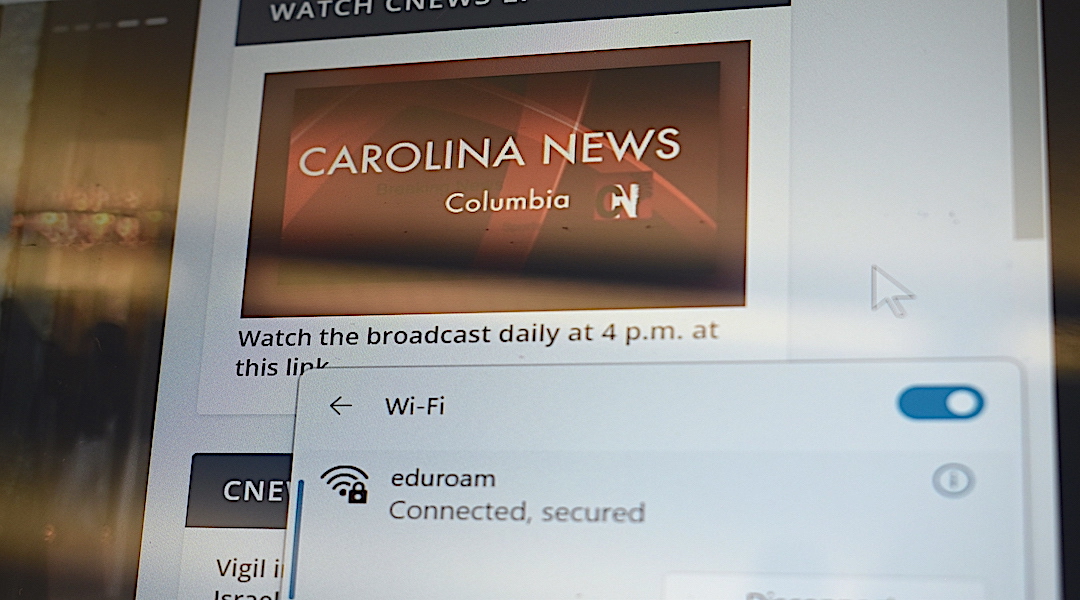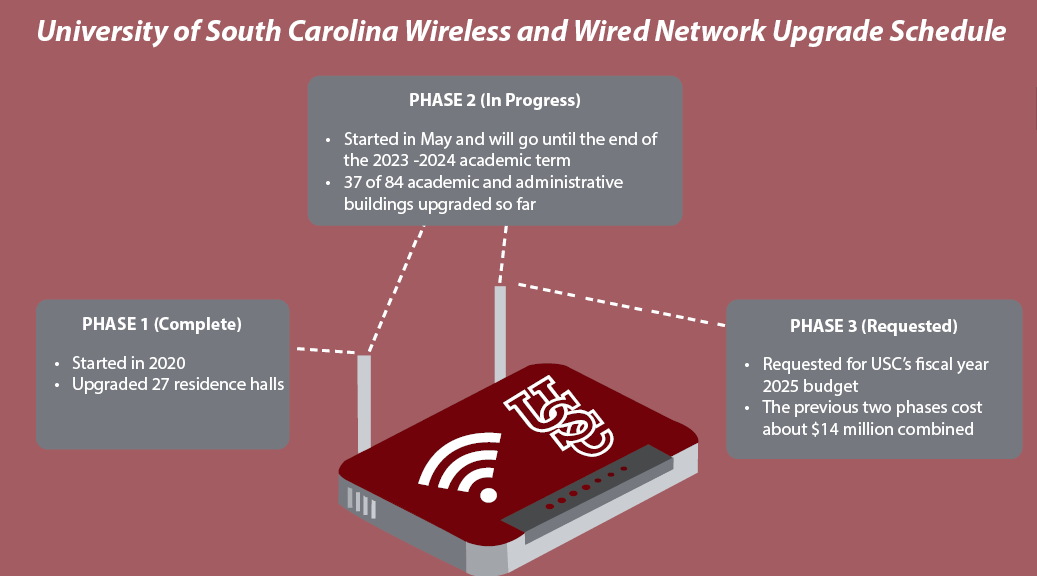USC’s goal for the network infrastructure upgrades is to decrease network outages by 90% (Photo by Jack Wolfe/Carolina News and Reporter)
Have problems with your internet on campus?
The University of South Carolina is working hard, it hopes, to make your Wi-fi better.
The university has upgraded 37 of 84 buildings for the second phase of its plan to replace the outdated hardware of its wired and wireless networks.
The Phase 2 upgrades began in May and will continue throughout the school year, according to Jeff Stensland, USC’s assistant vice president of institutional relations and public affairs.
“We are being mindful to not disrupt instruction during upgrade work,” Stensland said.
The work has been long awaited. Dorn Smith reminded his fellow Board of Trustees members Oct. 13 that cyber-infrastructure has been a problem for his 13 years on the board, as reported by The Daily Gamecock.
The upgrades are increasingly important. It comes as the number of users on campus has grown exponentially, with USC posting record-breaking freshmen enrollment each of the past two fall semesters. This fall’s freshman class, for example, was 7,344 students strong.
Feeling the lag
Jason Porter, an instructor for the School of Journalism and Mass Communications and a member of the SJMC tech committee, said the increase in students takes a toll on internet infrastructure.
“If the last big push to upgrade all the hardware was seven or eight years ago, technology has improved since then,” Porter said. “I’d also imagine the number of users and devices that we have on that network has exponentially gotten larger.”
The goal of the upgrades is to decrease network outages from failing hardware by 90% or more. The newer equipment is also installed to continue the use of up-to-date firmware and software, said USC’s interim CIO Beth Brigdon.
Phase 1 launched in 2020 with upgrades to the hardware of 27 residence halls.
Phase 2 is focusing on 84 academic and administrative buildings. The remaining 47 buildings will be worked on when school is not in session, Brigdon said.
The upgrades replacing access points that are 7 to 8 years old and routers that are more than 13 years old. A access point is a networking device that allows devices to connect to a wired network, according to Cisco.
USC has spent about $14 million so far for the first two phases, according to Stensland. Phase 3 has been requested through the strategic university funding process for fiscal year 2025, Brigdon said.
“The upgrades are great,” Porter said. “It just feels like it’s taking a long time.”
Freshmen Kennedy Jones and Francesca Zobrist have both had trouble connecting to the Wi-fi in their dorms.
“Kind of sucks, because I can’t lay in my bed and do homework,” Jones said.
In a student feedback survey from September 2022, 12% of the responses listed campus Wi-Fi when students were asked the best way to enhance the student experience.
Another reason the upgrade process can be time-consuming is because of security concerns, said Rhaynie Bongiorno, USC security analyst intern.
“These upgrades and migration have been really big plans since the summer,” Bongiorno said. “I started working with the security team in May, and they’ve been prepping for this migration for months.”
As new routers and access points are being installed in the buildings, there also needs to be a migration process to ensure the safety of the university’s firewalls, Bongiorno said.
“As you introduce new hardware, that hardware has to be configured in order to maintain a level of security.”
‘The plane’s gotta keep flying’
Maintaining IT services and infrastructure for a university requires constant effort, said Ryan Turner, the University of North Carolina’s director of networking for IT services.
“You have to continually invest and expand, especially in wireless access because not only are the devices multiplying, but you’re asking more of us for devices,” Turner said.
The number of people on a network is not the only factor to be considered.
The amount and types of devices each person has on that network have to be taken into consideration, Turner said.
“Look at what (TV) streaming has done in the last 10 years, where you were barely high-definition, and now people are talking about 8k,” Turner said.
Turner said it’s worthwhile for universities to fund IT as a strategic investment.
“It’s unfortunate that in a lot of places, IT has to really fight for their dollars to survive, despite the fact that institutions continually demand to ask more and more of IT,” Turner said.
Brigdon shares the same views as Turner when it comes to continually working on the maintenance of USC’s wired and wireless network.
“It’s kind of like maintaining the plane while it’s flying, cause the plane’s gotta keep flying,” Brigdon said.
While Phase 2 is still in the works, Bridgon said the university’s IT department continues to maintain network efficiency so students can continue work without interruption.
“The fact of the matter is we are doing maintenance all the time just to keep the lights on,” Brigdon said.
Freshmen Kennedy Jones and Francesca Zobrist have had trouble connecting to the Wi-fi in their dorms. “Kind of sucks, because I can’t lay in my bed and do homework,” Jones said.
The network upgrades are divided into three phases, with Phase 2 scheduled for the current academic term and Phase 3 requested for the fiscal year 2025 budget.
Ryan Turner, University of North Carolina director of networking for IT services, talks about fighting for IT funding.





